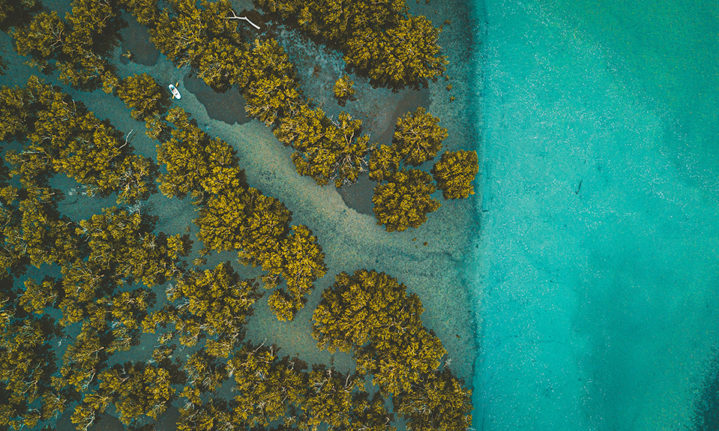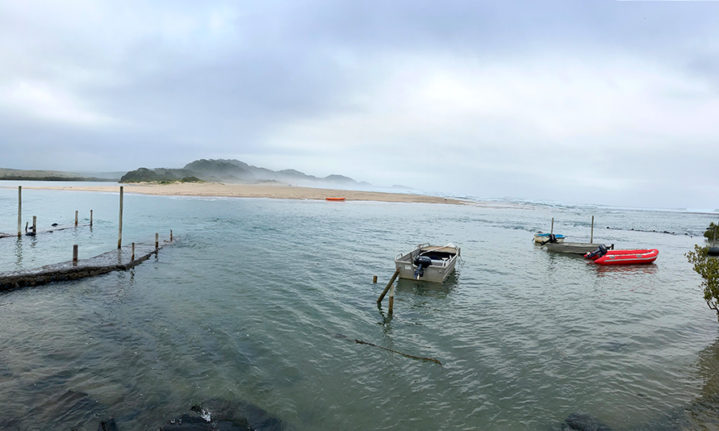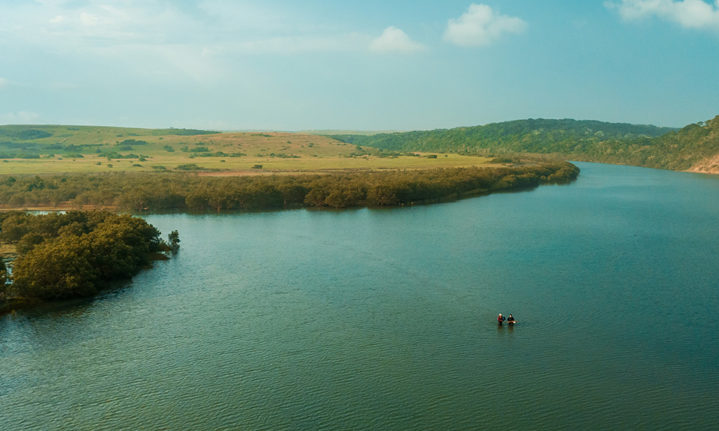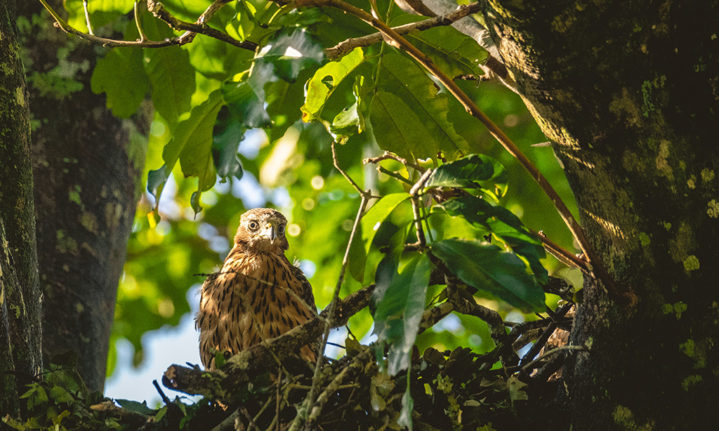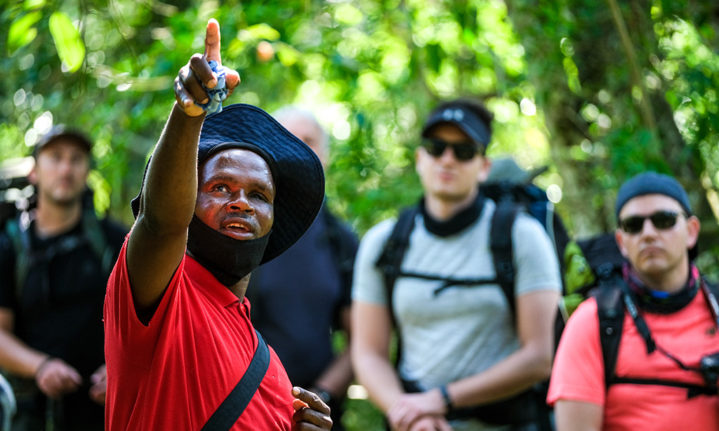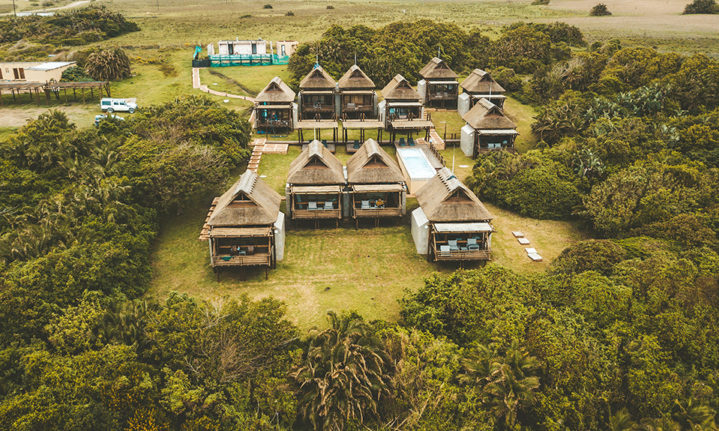In Nxaxo Estuary Jess Nicholson revels in nature’s bounty, the ship-wrecking history of its rocky shores and the remarkable adventurers that have made the Eastern Cape’s Wild Coast their home.
Jess Nicholson | Photos: Bruce Viaene
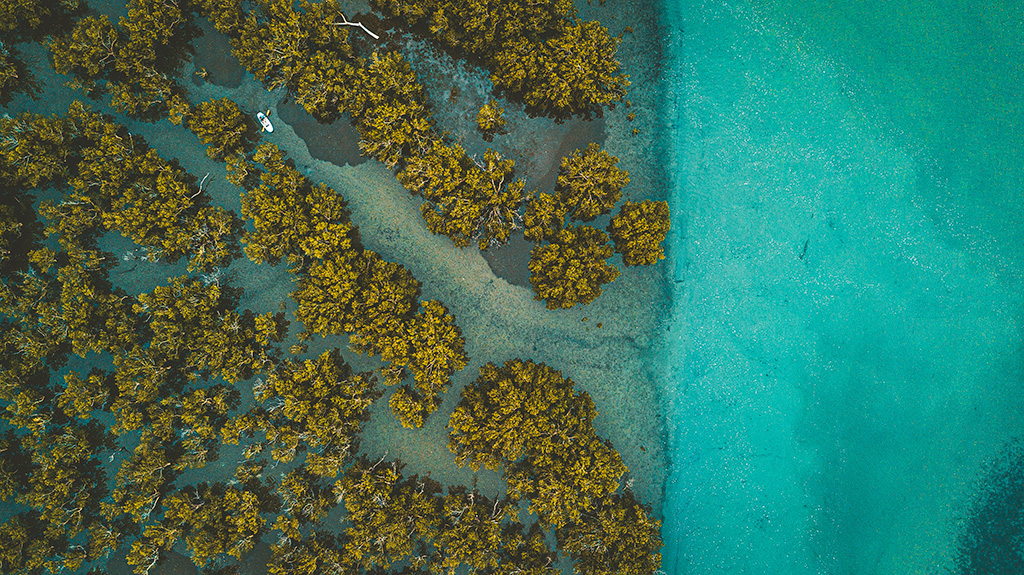
Islands of mangroves line the Nxaxo Estuary – at high tide you can paddle right up to the trees and their dwellers.
After a few kilometres of walking through the forests of Ndlezana along the cliffs of Africa’s wild edge, I start to feel that city life is too dog-eat-dog and I would prefer to take my chances living here in the forests with the birds, snakes and cows. Dinala Bistoli, our guide on a hike from Wavecrest Hotel to Trennerys, is fuel for falling in love with trees and off-the-grid fantasies.
‘Should we go up a steep hill and you need to open your lungs a little, we will use some of this,’ says Dinala, pointing at a bountiful bush of wild sage. A little further on he adds, reassuringly, that acacia bark will help sort out any broken legs. I also learn that wild figs make excellent bandages and the sour variety is a salve for stings. ‘And if anyone gets left behind and is stranded and hungry, milk from the Bushman’s poisonous tree will slow a bushbuck down, at least long enough to catch it for dinner,’ he jokes. Adding that if you accidentally eat some of the Bushman’s poisonous tree instead of using it to catch a bushbuck, then simply vomit it all up by eating some red beech.

For forest dwellers, or those just passing by, Ndlezana’s trees can be restaurant, refuge and pharmacy.
This is my first day exploring the Nxaxo Estuary and its surrounds, and as we emerge from the forest and make our way down to the beach towards the Kobonqaba River, we are greeted by a whale who squirts a hello and gives us a tail wave, then a huge pod of dolphins surf past having found the secret offshore right point break. Behind us, the last visible dune, shrouded in sea mist, myths and mystery, is Sandy Point.
It was from this place, about 200 years ago (1829), that another group began a long walk towards East London. Their tale was told in The Narrative, by one of Wavecrest’s more famous guests, David Culpin, who happened accidentally upon a lost manuscript when it fell out of a book in the Cape Town Library. Unlike us, who’d just had a good night’s sleep and hearty breakfast, these French travellers were cold, hungry, exhausted and shipwrecked; their destination before their ship, the Eole, sank, was Bordeaux; their understanding of surviving in Africa minimal. No doubt thanks to some of Dinala’s Xhosa ancestors, they made it to East London, and The Narrative is page after page of riveting adventure and insight. A tough act to follow but I had already learnt some secrets on the Wild Coast…
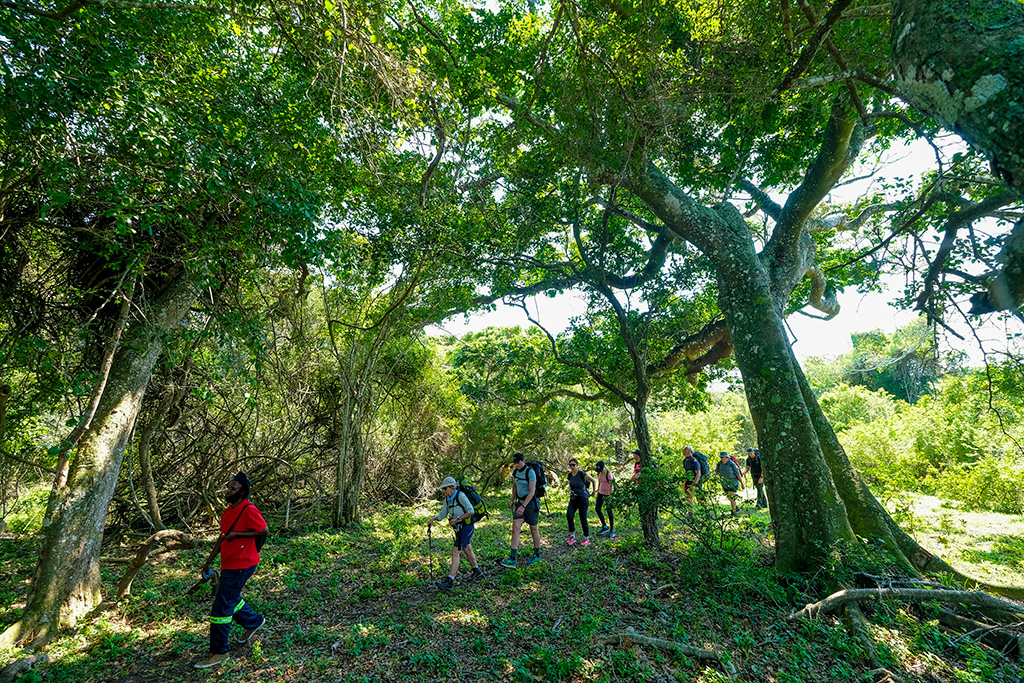
Dinala Bistoli guides walkers along a cattle track through the forest on a day hike from the Wavecrest Hotel to Trennerys.
For a start, the dunes at Sandy Point, which I explored the next day, and covered in part by dune forest, conceal a lot more than spotted ground thrush, Narina trogons, shells, and bits of shipwreck. Guests have returned to Wavecrest after an after-noon stroll with strange black rocks, now proudly displayed on mantelpieces across South Africa, and thought to be bits of meteorite. Someone once returned with photographic evidence of fossilised hippo footprints.
‘A while ago, sand from the dune swept back, revealing a swathe of clay imprinted with footprints. Proof, according to some, that there were hippos and elephants here thousands of years ago,’ said Sean Pike, a manager at the Wavecrest Hotel. ‘The sand has covered up the evidence again, and it’s difficult to locate the exact position precisely,’ he added, not giving away too much, and rightly protective of this incredible place from sudden block bookings by amateur anthropologists.
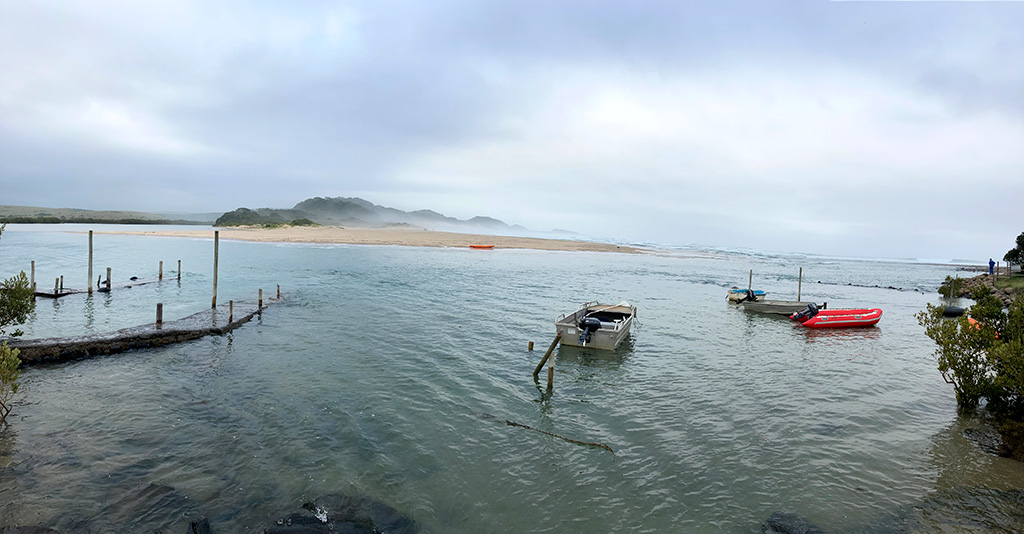
The dunes of Sandy Point have burried secrets: fossils, shipwreck treasure and bits of meteorite. (Photo Jess Nicolson)
Apart from those interested in trees, birds, geology, history and shipwrecks, guests at Wavecrest Hotel can chill on the beach, paddle on the estuary, walk in the forests and fish off the block – a concrete structure in the sea that facilitates anglers casting into a deep gully for potentially enormous kob. There is a family vibe, and many guests return every year.
Nosisa Songwelo, who has worked here for 23 years and remembers everyone, said one of her favourite guests is a woman from Canada. ‘She comes quite often, but not only for a holiday, she makes herself at home and likes to work. Once she spent three weeks making new curtains. Just because she wanted to,’ said Nosisa.
Others, engaging vigorously with this stretch of wild coast, might pop in just for a meal or an overnight rest. I met horse riders, more hikers, cyclists with supersized calves and the ability to carry their bikes on their heads through rivers. Ultrahuman André Redinger, who understandably lolled in the estuary for quite a long time, had run from Port Edward, testing out a new single stage 320km ultra trail run (The Baleka, rockethorseracing.co.za/the-baleka). And I know of two ultra-swims in the planning phase.

Between technical riding through forests and over precarious cliff paths, riders can let loose and gallop along long streches of beach.
‘The thing is, you can just keep going in either direction, it is completely safe,’ says Sean. ‘There are a couple of toothless sand sharks in the rivers, a good fight on the rod, but harmless. Many people come regularly for the fishing,’ he adds.
The Nxaxo Estuary is regarded as one of South Africa’s best angling destinations, because of all the options it offers, both in the sea and in the river mouth, where no watersports are allowed and the mangroves provide the perfect habitat for a variety of fish.
Bruce Viaene, expert adventure photographer, and unexpert fisherman, said as he was pleasantly surprised at how successful his angling expedition there was. Although he did mention that he’d seen a mullet so large he wouldn’t fancy his chances if the mullet was after him instead! Mullet aside, it was a peaceful experience: ‘It’s like being teleported into another world where the only sounds are of fish eagles, kingfishers, crabs scuttling among the mangroves, and the flapping of the spotted grunter…’ Bruce said.’

Scientists Wilmari Theron and Anusha Rajkaran spend many wet and muddly days in the estuary each year, checking the size and health of the mangroves.
Bruce’s trip to the estuary had begun in much faster-flowing water when he arrived at Gxara Falls and promptly backed off the top of the waterfall, abseiling down through a tropical canopy past some frogs and snakes into a large pool at the bottom of a canyon. ‘The canyon is basically untouched so we were swimming in huge pools and scrambling across massive rocks that no one has been on for years. Then I decided to run to Wavecrest along the beach. Just for fun.’
On my last day at Wavecrest, I was tempted by a trip to Collywobbles to hang out with vultures (one of South Africa’s largest Cape vulture colonies) but my new love affair with trees kept me in the estuary. Bruce came back from the outing raving: ‘Just driving there was exciting – the views are amazing. But arriving at the site is truly spectacular. The canyon carved out by the Mbhashe River below the nesting birds takes your breath away,’ he enthused. As did being surrounded by an overwhelmingly large number of enormous vultures floating about on the thermals. ‘They are everywhere, above you, below you, next to you. I could have watched them for days.’

A juvenile black sparrowhawk, one of three chicks raised in this nest.
There were birds in my day, too, as I paddled up the Nxaxo at sunrise. Seven species of kingfisher, to be precise. And crabs, scuttling around on the mud, which looks like the surface of the moon, or a brand new very holey planet. And scientists, Anusha Rajkaran and Wilmari Theron, who were immersed in the muddy swamp, meticulously measuring saplings and performing health checks on the adult mangroves. I immediately sank into the mud as I stepped out of the kayak to get a closer look at the aerial roots growing skywards for breath. And at the branches of the white mangroves, some sacrificing themselves to die of salt absorption, thus allowing the rest to live.
Anusha explained how the mangroves support the whole estuary, performing what is termed an ecosystem service. ‘These are not just trees, but a life-giving force, with the potential to save all our lives. They are a gift to the planet which many of us can’t see,’ she said. Mangroves do this by taking carbon out of the atmosphere and storing it in the sediment. Effectively they are carbon sinks, counteracting the carbon footprint humans leave.

Seeing eye to eye with a Cape vulutre at Collywobbles, one of SA’s largest colonies.
And so a fitting end to my trip, and back to where I had begun, because whether it’s a story about shipwrecks or swimming or sunbathing or adventure and indigenous insight, travel writers like to return in a neat arc where we started: in this case a crush on trees. And I realised, unlike so many of my previous love affairs, this one is requited. The trees of the forests and the estuary keep on quietly loving us back: giving us fish and fishing, and birds and birdwatching and photography and peaceful kayaking down the river; the best holidays and the best adventures; and the secret to life itself.
Fascinating Facts
Fact 1: French wreck
The Narrative of the shipwreck of the French Vessel, the Eole on the Coast of Kaffraria in April 1829 by CE Boniface, was discovered by Englishman David Culpin in the Cape Town library, who translated it into English. It is now regarded as a pivotal contribution to the travel writing genre, and the first French book and travel narrative published in South Africa. Culpin came to Wavecrest to look for the shipwreck in 2014. At first the lines of latitude and longitude he followed placed the wreck somewhere in the Karoo, but with some adjustments, he found the wreck at Sandy Point.
Fact 2: precious stones
In the 1920s, diamond fever gripped the area when the son of German settler, John Bock, found a diamond on a floodplain of the Great Kei River. Prospectors and miners flocked to the area but eventually only found about 1 000 diamonds. It is now thought the diamonds were from the Grosvenor, which was wrecked at Port St Johns in 1782.
Fact 3: from the heavens
Since 1800, 158 observed meteorite falls have been recorded in Africa. The largest in the world, the 60 ton ‘Hoba’ meteorite, can be viewed near Grootfontein in Namibia.

Looking down the smaller Ngqusi River to its confluence with the Nxaxo, in front of Wavecrest Hotel. Dawn risers could be rewarded with sightings of seven species of kingfisher, including the elusive mangrove kingfisher.
Local Characters
The Transkei Cowboys
Photographer Bruce Viaene, from East London, has been coming to Wavecrest since he was a child. He got married in the Ndlezana Forest, and his wife and two daughters come to Wavecrest whenever they can. Bruce, who focuses on adventure photography, has teamed up with Christo van der Ham, a shark attack survivor and Tagan Smith, a travel guide and surf instructor. Together, the trio are working on a series of short films to show the world the Wild Coast. ‘The area around the Kei Mouth and Wavecrest is not well known. We simply want to tell the stories of the people who live here and let the world know what this part of the Wild Coast has to offer. Covid-19 has had such a significant and devastating economic impact on the Eastern Cape, which relies so much on tourism. We wanted to help. And while people are may still be wary of travelling, they can share in our adventures on Youtube. And hopefully soon, they’ll be confident enough to experience it for real,’ says Bruce.
transkeicowboys.co.za
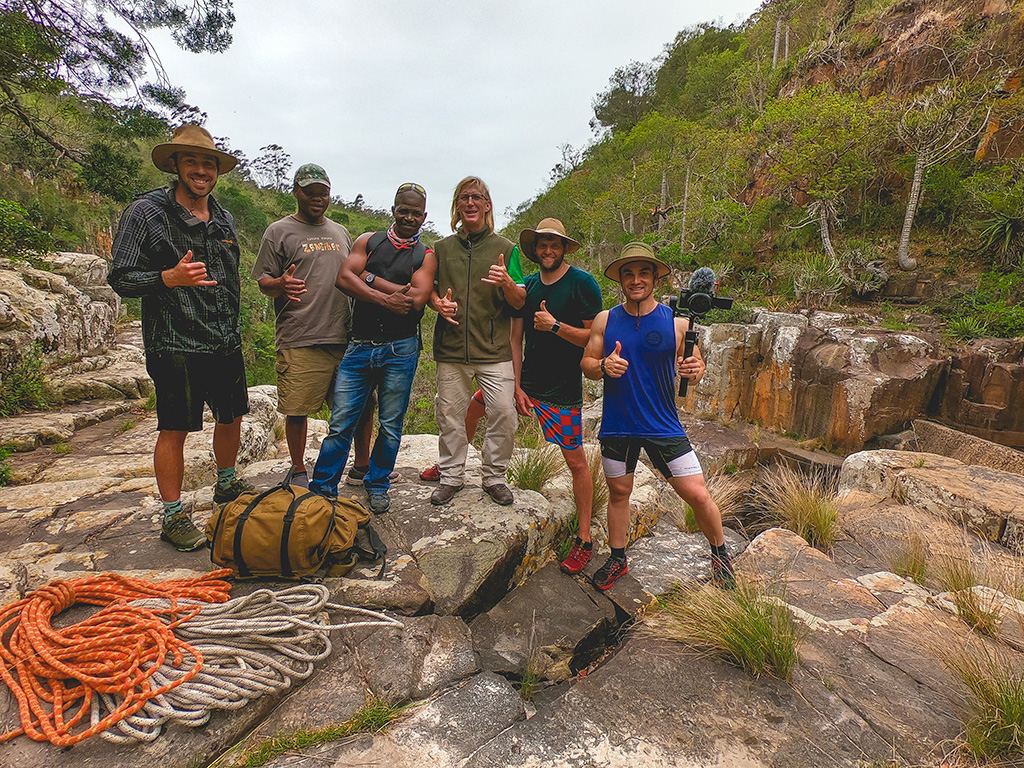
The Cowboys & compadres
Sean Pike
Sean Pike is a man of ceaseless energy, ferrying visitors up and down the estuary to find kingfishers, rescuing kayaks which float down the river when the tide comes in, driving the dusty roads to find vultures, and has a favourite memory of one particular guest: ‘Once, while I was guiding a group through the forest, I almost stepped on a very upset night adder. I came to a sudden stop, centimetres from the snake, and the young woman walking behind me didn’t stop as quickly and walked into me, inadvertently pushing me onto the snake. The trodden-on night adder then struck at me several times. In my unbalanced state I managed to get my boot in the way to take the strikes. While I was one-legged, dancing and fending off the strikes with my boot, the young lady promptly climbed me like a ladder, making her way up my legs onto my back. Fortunately the snake took off at great speed after seeing this two-headed dancing giant.’
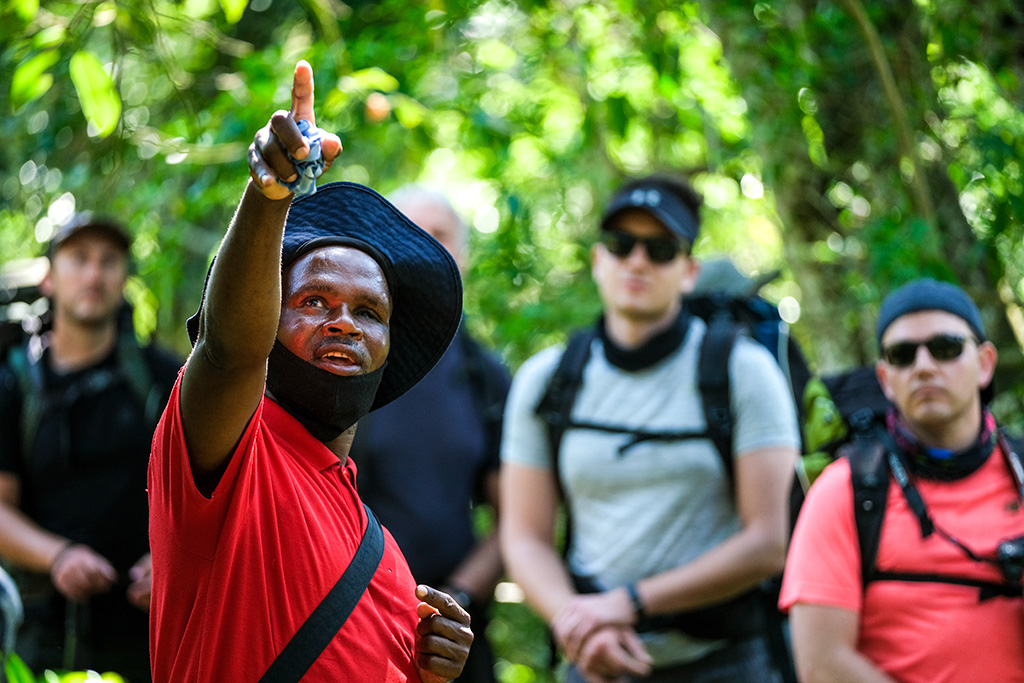
Dinala Bistoli
Dinala Bistoli
Dinala is from Nombanjana village and has been a tour guide since 2003, taking hikers from the Wavecrest Hotel through the forests and along the cliffs to the Kobonqaba River, and then along the beach to Trennerys. Dinala has lived here all his life, knows every plant, bird and animal on the land and in the sea, and he is very protective. He has chased abalone thieves off the rocks and strelitzia thieves out of the forests. The people in his village are farmers or make a living as tour guides or porters on slackpacking routes. Some fish and sell mussels and oysters to the hotels along the coast.

Trip Planner
Do This
The hike I joined was part of the Wildcoast Meander, a five-day affair starting from Kobb Inn and ending at Morgan Bay, with stops at Mazeppa Bay, Wavecrest and Trennerys. Other organised slackpacking options are the Wild Coast Pondo Walk and the Wild Coast Amble.
043 743 6181
wildcoastholiday.co.za/listing/wild_coast_holiday_hiking
Based at Kei Mouth, Wild Coast Horseback Adventures offers beginner rides on the beach, day rides from Kei Mouth to Trennerys Hotel or Gxara Falls, mini-trails or week-long rides between Kobb Inn and Kei Mouth.
082 567 0972
wildcoasthorsebackadventures.com
Active Escapes organises cycling tours in the area.
033 329 5259
active-escapes.co.za
Alternatively you can hire a bike from Wavecrest Hotel.
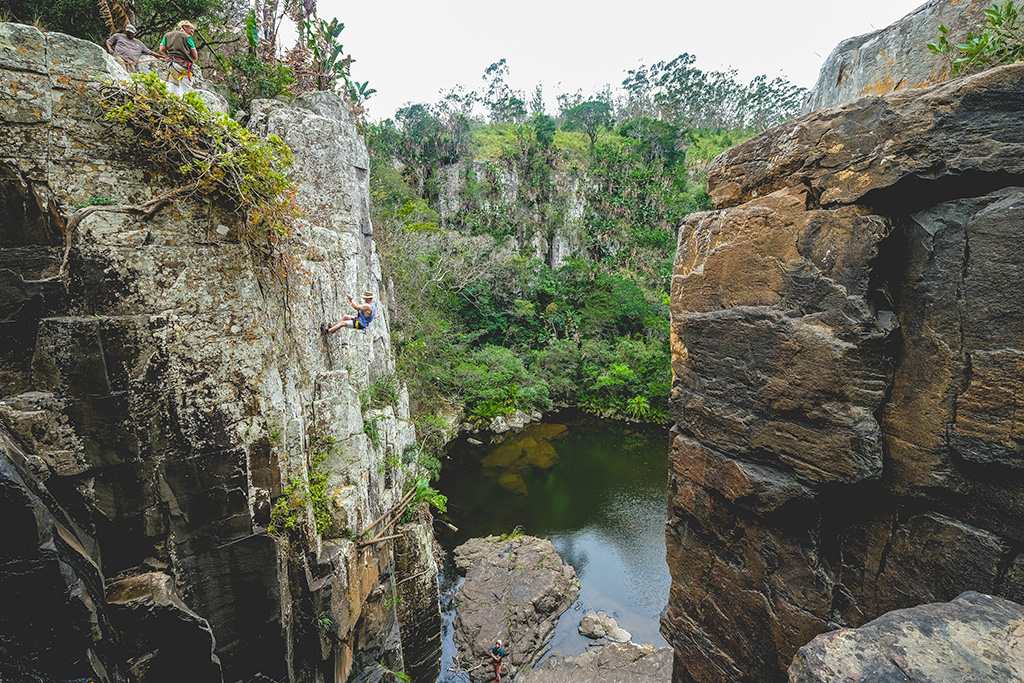
Abseiling Gxara Falls
Morgan Bay Adventures organises abseiling for all ages and levels of experience. Apart from abseiling down Gxara Falls, there are around 500 short climbing routes to choose from.
078 296 4906
morgan-bay-adventures-ptyltd.business.site
Boat and kayaking trips from Wavecrest go up the estuary to see kingfishers (including the mangrove kingfisher in spring and summer). Waders, wagtails, crowned eagles and herons abound, as well as forest specials such as the spotted ground thrush and narina trogon. The hotel also organises 4×4 trips to the Collywobbles Cape vulture Colony.
047 498 0022
wavecrest.co.za
Kayaks are available free to guests.
047 498 0022
wavecrest.co.za
Wavecrest is in close proximity to the shipwrecks of the Boundless (2013), Jacaranda (1971), the Talana (1934), and the Eole (1829).
Stay Here
The Wavecrest Hotel is the only accommodation option at Nxaxo Estuary.
The Wavecrest Hotel
High season: R1 500 pp sharing (DBB)
Low season: R750–R1 000 pp sharing (DBB)
047 498 0022
wavecrest.co.za
Nearby stays (many hikers walk between these hotels)

Wavecrest Hotel
Trennerys Hotel
High season: R1 450 pp (DBB)
Low season: R1 005 pp (DBB)
Camping: R295 per adult
047 498 0004
trennerys.co.za
Mazeppa Bay Hotel
High season: from R890–R1 550 pp sharing (all meals included)
Low season: R760 to R1 100 pp (all meals included)
047 498 0033
mazeppabay.com









